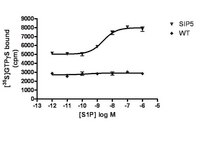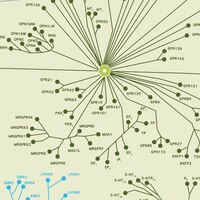HTS193M Sigma-AldrichChemiSCREEN™ Membrane Preparation Recombinant Human S1P5 Lysophospholipid Receptor
Human S1P5 / EDG8 GPCR membrane preparation for Radioligand binding Assays & GTPγS binding.
More>> Human S1P5 / EDG8 GPCR membrane preparation for Radioligand binding Assays & GTPγS binding. Less<<Recommended Products
Overview
| Replacement Information |
|---|
Key Specifications Table
| Species | Host Cells | Protein Target |
|---|---|---|
| Human | Chem-5 | S1P5 / EDG8 |
| References |
|---|
| Product Information | |
|---|---|
| Format | Membranes |
| Presentation | Liquid in packaging buffer: 50 mM Tris pH 7.4, 10% glycerol and 1% BSA no preservatives. Packaging method: Membranes protein were adjusted to 1 mg/ml in 1 ml packaging buffer, rapidly frozen, and stored at -80°C |
| Quality Level | MQ100 |
| Physicochemical Information |
|---|
| Dimensions |
|---|
| Materials Information |
|---|
| Toxicological Information |
|---|
| Safety Information according to GHS |
|---|
| Safety Information |
|---|
| Storage and Shipping Information | |
|---|---|
| Storage Conditions | Maintain frozen at -70°C for up to 2 years. Do not freeze and thaw. |
| Packaging Information | |
|---|---|
| Material Size | 200 units |
| Transport Information |
|---|
| Supplemental Information |
|---|
| Specifications |
|---|
| Global Trade Item Number | |
|---|---|
| Catalog Number | GTIN |
| HTS193M | 04053252400780 |
Documentation
ChemiSCREEN™ Membrane Preparation Recombinant Human S1P5 Lysophospholipid Receptor SDS
| Title |
|---|
References
| Reference overview | Pub Med ID |
|---|---|
| Edg8/S1P5: an oligodendroglial receptor with dual function on process retraction and cell survival Jaillard, C, et al J Neurosci, 25:1459-69 (2005) 2005 | 15703400
 |
| Sphingosine-1-phosphate: an enigmatic signalling lipid. Spiegel, Sarah and Milstien, Sheldon Nat. Rev. Mol. Cell Biol., 4: 397-407 (2003) 2003 Show Abstract | 12728273
 |
| Characterization of a novel sphingosine 1-phosphate receptor, Edg-8 Im, D S, et al J Biol Chem, 275:14281-6 (2000) 2000 | 10799507
 |
Data Sheet
| Title |
|---|
| CHEMISCREENTM MEMBRANE PREPARATION RECOMBINANT HUMAN S1P5 LYSOPHOSPHOLIPID RECEPTOR |








